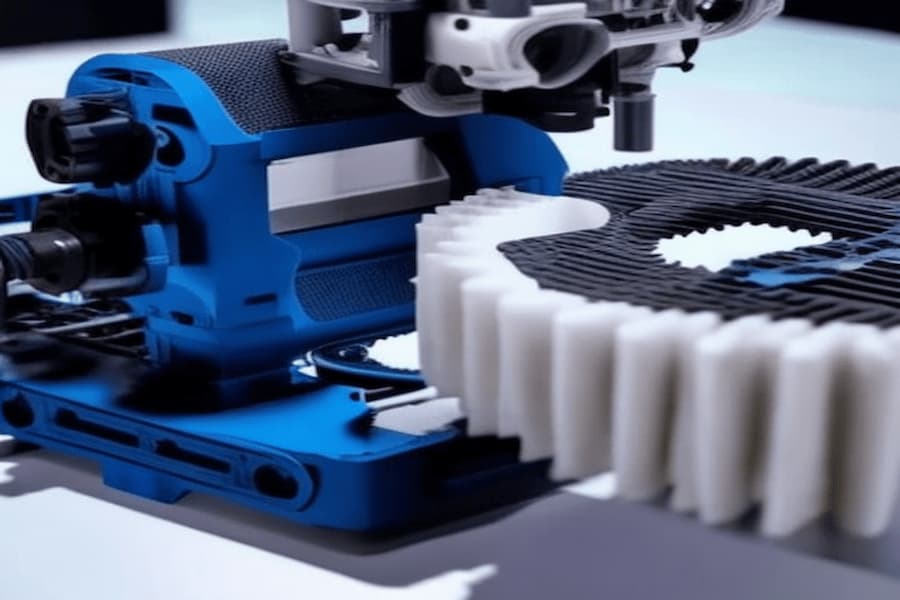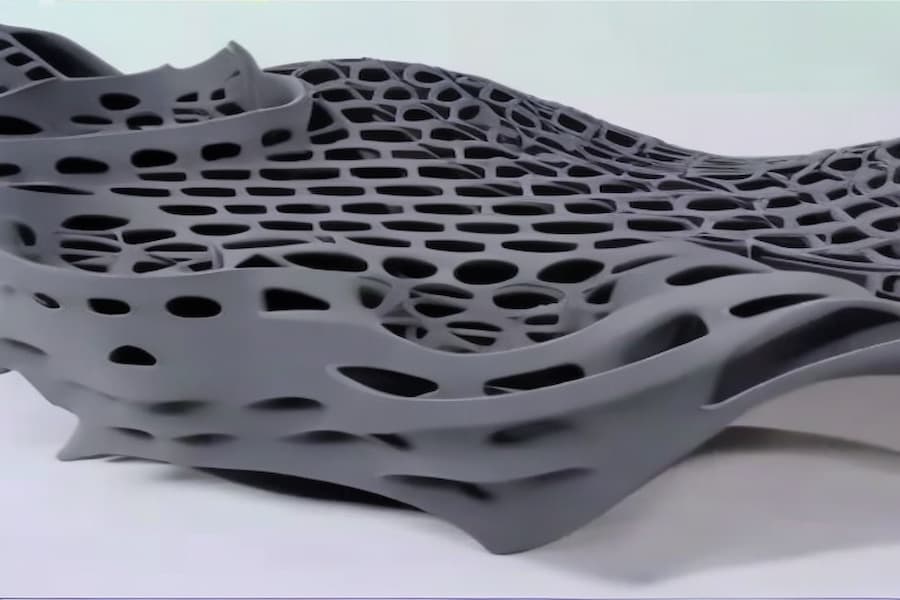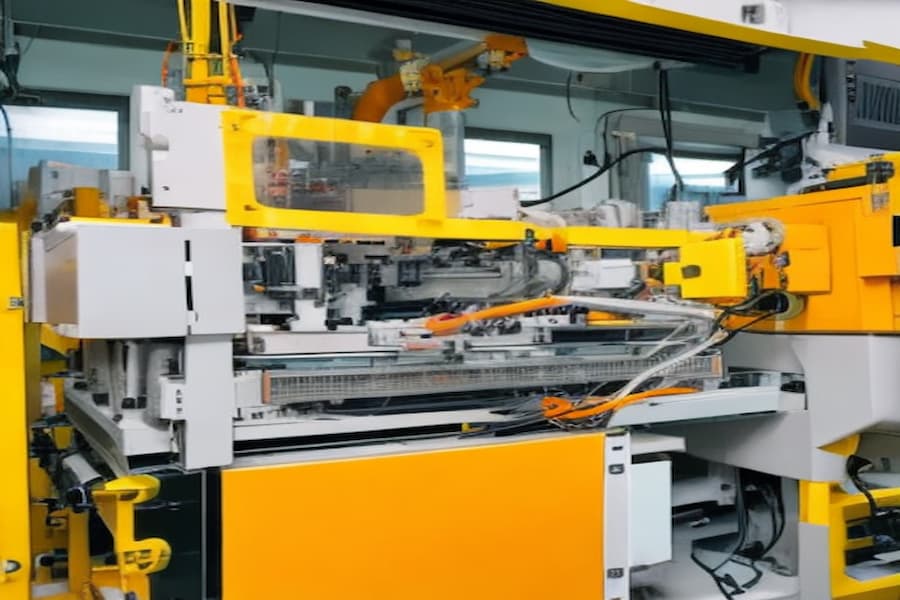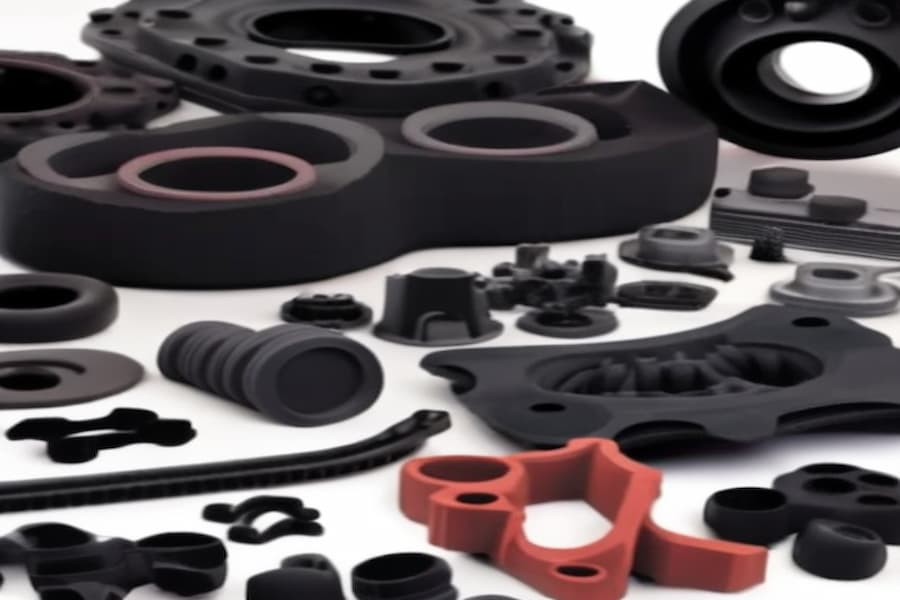Are you aware of additive and subtractive manufacturing ideas? The subtractive method includes eradicating supplies to attain the specified form, whereas additive methods construct the form from layers of materials. Right here, 3D printing and compression molding are two additive manufacturing strategies. Nonetheless, there are several essential variations between 3D printing and compression Molding.
The distinction is in manufacturing velocity, effectivity, design flexibility, precision, and purposes. Moreover, in this article, we will study and compare the nuances of those two strategies.
What Is 3D Printing?
Its additive manufacturing expertise creates exact and complex practical parts or merchandise by stacking and fusing successive layers of fabric. So, a 3D printer doesn’t use a fabric block to govern the form. As a substitute, the nozzle deposits materials layer by layer from the underside up within the print mattress based on the slice sample of the uploaded design.
In the meantime, slice sample refers back to the person’s horizontal layers into which a CAD mannequin is split. Every slice represents a cross-sectional space of the dummy that the printer follows to deposit the fabric layer.

Moreover, you might want clarification on several 3D printing technologies. Although they observe identical fundamental precepts, their working mechanism, materials compatibility, and printing capabilities vary. Listed below are the frequent types of 3D Printing technologies.
| Kind | Supplies | Description/Working | Execs | Cons |
| FDM (Fused Deposition Modeling) | Thermoplastics (ABS, PLA, Nylon) | It melts and extrudes the fabric filament layer by layer to attain the ultimate form. | Structural stability, low price, numerous supplies | Rougher end and average precision |
| SLA (Stereolithography) | Photopolymer Resin | SLA employs an ultraviolet laser to remedy photopolymer resin in a tank, creating layers. | Excessive precision, easy finishes, and creates detailed fashions and prototypes. | Restricted materials alternative |
| SLS (Selective Laser Sintering) | Polymer Powder(Nylon PA 12, glass-filled Nylon | A laser beam sinters materials powder in a chamber, usually with inert gasoline, to forestall oxidation. | Advanced geometries attainable | Longer lead instances and tough floor texture |
| DMLS (Direct Metallic Laser Sintering) | Metallic Powder (numerous alloys, aluminum, copper, nickel ) | DMLA fuses metallic powder particles layer by layer with a laser. | Prints intricate and robust metallic parts. | Excessive price and restricted materials selections. |
Advantages of 3D Printing
3D printing manufacturing is advantageous for several purposes. It gives design flexibility, sooner lead instances, customization, and many others. Right here is the elaboration of typical 3D printing benefits;
Design Flexibility and Complexity
If we compare the design’s attainable intricacies with compression molding and 3D Printing, we can see that a 3D printer creates extremely advanced geometries and contours. It additionally provides more complexity than standard strategies like CNC lathe machining or injection molding. It doesn’t limit intricate hole sections, undercuts, and inner lattices as subtractive manufacturing does.

Moreover, the functionality of advanced shapes directly benefits designers. They’ll make more progressive and complex designs to resolve manufacturing needs. Furthermore, designers shouldn’t have to consider draft angles, software entry, thickness uniformity, massive meetings, and different restrictions when making 3D printing designs. So, it leads to final design flexibility.
Fast Prototyping
Manufacturing velocity, good precision, and cost-effectiveness make 3D Printing a dependable possibility for fast prototyping tasks. Depending on the complexity and 3D-printed supplies, an element could take a few minutes to several hours. Moreover, prices are lower with 3D printing prototyping due to zero upfront tooling cost and a straightforward design-changing process.
For instance, you can rapidly prototype and evaluate a brand-new drone design with vital changes on the fly by 3D printing iterations. At the same time, with different strategies, it’d take as much as months.
Customization and Personalization
The 3D printing processes are directly manufactured from digital information to deal with advanced designs. Consequently, 3D printing permits for {custom} parts and merchandise based on particular wants. When you’ve got a {custom} design (3D Mannequin), you can precise it into bodily actuality with appropriate supplies and printing gear.
This customization is extensively helpful for medical purposes. For instance, 3D Printing can manufacture custom-fit-implants for sufferers.
Value-Effectiveness for Small-Batch Manufacturing
The principal reason for the low price of 3D-printed parts in small-batch manufacturing is that they don’t require costly manufacturing setups like molds or tooling. In the meantime, different approaches like injection molding require heavy upfront investments in molds, which result in more significant per-part solids for small batches or low-volume manufacturing.
For instance, small-batch manufacturing for Nylon parts first calls for an aluminum injection mildew that costs a minimum of $10 0 00, whereas there is no such price for 3D Printing.
Limitations of 3D Printing
Though 3D Printing has many advantages, it has some limitations, such as material alternatives, measurement, precision, and floor end. Let’s discuss each downside individually.
Materials Limitations
The fabric alternative is smaller for 3D Printing than for different processes like CNC machining. There are even fewer choices in 3D Printing vs. compression molding. The 3D printing machines are sometimes suitable with plastics (ABS, PETG, and TPU), photopolymers, a few thermoset supplies, and metals (metal, titanium, and aluminum).
Nonetheless, 3D Printing has quickly expanded its materials capabilities beyond fundamental thermoplastics. More supplies have become suitable because of material science improvements and new 3D Printing applied sciences.
Decrease Power and Sturdiness
As 3D printers convert the design by including materials layers, the final half compromises the mechanical energy. For example, FDM parts delaminate or underperform underneath stresses on the Z-axis’s specific orientations (Z-rally). Moreover, parts could lose their authentic properties, such as hardness or fatigue energy. For these reasons, the parts additionally become much less sturdy.
Floor End and Precision
The parts from 3D Printing depart from visible layer marks and sometimes some residual support materials. So, they require post-processing, such as sandblasting, deburring, and even machining. The Ra worth for 3D printing parts could be as little as 4 µm (approx.).
It is usually much less exact than standard manufacturing applied sciences. 3D Printing sometimes gives a precision of ±0.2 mm, whereas CNC can obtain ±0.005 mm and ~±0.025 for compression molded rubber parts.
Measurement Limitations
3D Printing has half-measurement limitations when evaluating processes like injection molding or laser reduction. The dimensions functionality is restricted by the construct quantity and mattress measurement (print chamber) of the 3D printer machines. For instance, 3d Printing can create lengthy wind turbine blades due to measurement limitations. Massive parts are attainable by assembling the small particular person 3D-printed fragments.
What’s Compression Molding?
It’s a specialized polymer molding process that creates the specified form by compressing the fabric in a closed mold. This manufacturing technique is standard for thermoset composites with superior properties.

The compression molding process calls for a multi-cavity compression mildew that exacts the unfavorable geometry of the specified form. In the meantime, the mildew consists of two halves (fastened decrease and movable higher halves). First, a pre-calculated quantity of fabric is contained in the heated mildew cavity, which is heated and compressed. Here, compression and mildew heating force the fabric to stream by the cavity and fill it.
Nonetheless, setting the suitable stress, temperature price, and curing time is crucial during compression. Subsequently, the mildew opening reveals the solidified half after cooling.
Advantages of Compression Molding
The next are the well-recognized benefits of compression molding throughout numerous manufacturing purposes.
Excessive Quantity Manufacturing Effectivity
Manufacturing quantity is probably the most invaluable benefit, particularly when evaluating compression molding and 3D Printing. When you make the mildew, you can reuse it to fabricate identical parts in excessive volumes, as many as thousands of cycles. Nonetheless, mildew’s lifetime depends on mildew materials, cost abrasiveness, and different elements.
This high-volume manufacturing effectivity reduces the cost-per-part considerably in the long term. Alternatively, there is no such thing as a per-part-cost discount with 3D printing mass production.
Excellent Power and Sturdiness
As a substitute for a layer-by-layer construction, molded parts contain compact and squeezed structural types. So, compression molding gives incredible half energy. Consequently, there’s a low likelihood of void formation, contributing to the beautiful structural integrity of parts.
In keeping with related research, the energy, hardness, tensile energy, and elasticity of compression-molded samples have been greater than those of 3D-printed parts throughout testing.
Good Floor End
This molding technique molds parts with a superb floor end. This is because the compression conforms materials intently to the mildew surfaces. Conform intently to the mildew surfaces. It may obtain Ra values from as little as 0.1 micrometers (µm) with extremely polished molds and optimum processing situations. In the meantime, the floor end of the cavity wall is essential for the sleek end of compression molding elements.
Suitability for Massive Components
The achievable measurement of parts with compression molding depends on the mildew measurement. So, you can create the more significant parts by designing an appropriate mildew and utilizing high-compression tonnage. For instance, plane wing pores and skin are feasible with CM.
Subsequently, pre-placing the cost materials within the mildew, as an alternative to utilizing injection strategies, facilitates large-sized molding. Compression permits the fabric to be distributed evenly throughout a big mildew cavity without the constraints imposed by the stream and stress necessities.

Limitations of Compression Molding
Compression molding gives quite a few benefits, but it has limitations in design flexibility, tooling price, manufacturing time, and tight precision. Understanding this limitation may help you avoid attainable defects within the remaining molded parts and make higher selections. Right here is the outline of every limitation;
Restricted Design Complexity
Compression molding is preferable for giant and comparatively easy designs. Right here, restricted design flexibility is mainly due to materials stream patterns in intricate mildew cavities of compression mildew. The fabric stream fails to fill these cavities precisely if the designs have advanced options like intense slanted angles and small particulars on corners.
Moreover, materials stream limitation may also lure compressed air, inflicting void formation. Alternatively, 3D Printing gives designers intensive freedom.
Increased Tooling Prices
If we compare the tooling price of 3D Printing to compression molding, mold tooling is considerably higher. That is due to the high upfront cost of mold and other auxiliary tooling. Moreover, slight adjustments in designs require vital funding in mold once more. Conversely, 3D Printing doesn’t have costly tooling prices.
Longer Cycle Instances
The compression molding course usually has an extended cycle, even for compression molding vs injection molding. It includes preheating mildew and cost, pre-loading of cost, and comparatively longer curing time, all contributing to the upper manufacturing time. Subsequently, the flash and burrs removing course of the molded floor after manufacturing additionally providprovidee time.
High quality and Precision Points
Lastly, plastic compression molding struggles to attain excessive accuracy and high quality, as in other manufacturing strategies. That is preliminary because of a much less uniform materials stream than other strategies. Subsequentity points may be shrinkage and warpage since all thermoset and thermoplastic supplies shrink to some extent throughout cooling.
Concerning precision, the compression molding tolerance sometimes ranges from ±0.127 to ±0.508 mm. The tolerance varies chiefly based on the mildew cavity floor quality, course parameters, and properties of the cost materials.
Variations Between 3D Printing and Compression Molding
After understanding the pros of 3D printing and compression molding, let’s talk about the head-to-head comparability of those processes in total facets.
Materials Choice
Materials choice inspires the properties and performance of the final part, no matter the manufacturing technique. So, having more material choices means more possibilities to get the fabric that precisely addresses your necessities.
| Materials Kind | 3D Printing Supplies | Compression Molding Supplies |
| Thermosetting Plastics | Nearly No, In only a few specialized eventualities | Epoxy, Phenolic, Polyester, Vinyl ester, Melamine |
| Thermoplastics | ABS, PLA, PETG, TPU, Nylon, PEEK, PC | Polyethylene (PE), Polypropylene (PP), Nylon (Polyamide), Polycarbonate (PC), Acetal (POM) |
| Composite Supplies | Carbon Fiber Strengthened PLA, Glass Fiber Strengthened Nylon, Wooden-Crammed PLA, Metallic-Crammed PLA, Kevlar-Crammed Nylon | Glass Fiber Strengthened Plastic (GFRP), Carbon Fiber Strengthened Plastic (CFRP), Sheet Molding Compound (SMC), Bulk Molding Compound (BMC), Fiber-Strengthened Thermoset |
| Metals | Titanium, Aluminum, Inconel, Copper, Gold, Silver | In only a few eventualities |
You will discover more material choices for 3D Printing than compression molding. Nonetheless, it’s worthwhile to contemplate price, your necessities, design specification, the supposed use of ultimate parts, and whether the fabric suits each strategy for Totally different Scales.
The price of 3D Printing vs compvs. Compression molding is closely dependent upon the manufacturing quantity. The excessive mildew price in compression molding makes it inexpensive because the manufacturing quantity will increase. In the meantime, 3D prin3Dng doesn’t leverage a significant discount in manufacturing prices with large-scale manufacturing.
| Manufacturing Scale | 3D Printing | Compression Molding |
| Prototyping | Low price (No molds required) | Excessive price (Molds required) |
| Small-batch | Reasonable price | Excessive price on account of preliminary mildew funding |
| Medium-Quantity | Excessive price on account of slower manufacturing velocity | Reasonable price (Amortization of mildew price) |
| Excessive Quantity | Excessive-cost | Low price |
Subseq Subsequently, the prices of compression molding improve with intricacies because it requires extra advanced mildew and reduces the cycle time. In distinction, the fee won’t improve with advanced 3D printing designs. Since materials utilization has a significant share of the general price, the cost could be decreased if advanced parts want a much smaller quantity of materials for 3D Printing.
Velocity and Effectivity in Manufacturing
Unlike the prototyping tasks, 3D Printing is a much less speedy course than molding. Compression molding takes far more time in prototyping due to mold-making and tooling preparations. Nonetheless, compression molding machines instantly go for the subsequent cycle after cooling the mildew. So, compression molding velocity is restricted in prototyping and small-batch manufacturing.
Subsequently, the effectivity of 3D Printing decreases as manufacturing quantity increases. Nonetheless, it’s extremely environmentally friendly for producing advanced elements without further prices. Alternatively, compression molding excels in scalability. It may create 1000s of thousands of millions of constant models at a comparatively low cost.
High quality and Sturdiness of Completed Merchandise
First, we are going with the standard of compression molding and 3D Printing. The structural quality of molding parts is more excellent than that of 3D-printed ones. It’s all due to their formation course. The layer-building strategy of a 3D printer lowers the structural energy of the half, whereas stress throughout compression molding makes the parts structurally intact. Consequently, the end high quality of the printed floor differs by the printing technique. For instance, FDM prints show layer traces and want an additional ending; the SLA technique produces smoother surfaces. In the meantime, compression molding gives a constant and smoother end.
Moreover, which of them is the strongest? The reply is compression-molded ones. This is due to materiality and the effects of matter and stress throughout curing. Alternatively, layered buildings introduce vulnerabilities within the 3D printing product.
Design Flexibility
As mentioned, the discussion gives more desimoreexibility than the compression molding method. Mildew manufacturing is a posh courscostly process; machining doesn’t assist the design of intricate inner geometries. In the meantime, 3D Printing doesn’t have any such limitations.
Right here is the record of options 3D Printing can accommodate; however, not by compression molding.
- Advanced undercuts
- Deep and small pockets
- Components with extremely variable wall-thickness
- Intricate floor patterns
- Sharp edges, and many others.
Suitability for Numerous Industries and Functions
Since compression molding can mildew rubbers and elastomers into sturdy and sturdy elastic parts, seals and gaskets are the two most typical purposes. Alternatively, 3D Printing is appropriate for prototyping and {custom} manufacturing.
| Business/Software | 3D Printing Examples | Compression Molding Examples |
| Aerospace | Gas nozzles for jet engines, brackets for satellite TV for TV elements, drone parts, and numerous prototyping. | Much less standard, celling for plane |
| Automotive | Cooling ducts, personalized dashboard elements, physique half prototyping, and inside elements | Gaskets and seals, rubber hoses and belts, and vibration-dampening elements. |
| Healthcare | Customized surgical fashions, dental crowns & bridges, {custom} prosthetic limbs, and many others. | Parts for sturdy medical gear, seals for laboratory containers, silicone masks, and extra. |
| Client Merchandise | Smartphone circumstances, custom-fit footwear, toys, and extra. | Watch casings, non-slip grips for instruments, sports activities gear, and hermetic meal storage containers. |
| Electr. omics | Customized enclosures, numerous prototyping | Buttons and keypads for distant controls, sturdy door lighting elements, insulating housings for connectors |
What is the proper way to make the appropriate selection between compression molding and 3D Printing?
There are several issues in deciding which strategies fit your needs, such as 3D Printing and compression molding. It primarily depends on the manufacturing quantity, design complexity, half measurement, and value. As a Forle, 3D print manufacturing is appropriate for small-size {custom} parts manufacturing in low quantity. In distinction, compression molding excels in producing large-size elements in greater quantity.
Nonetheless, consulting with business leaders like LongSheng is helpful earlier than determining the fitting on 3D Printing vs compression molding. We’re on the entrance foot of on-demand manufacturing providers, together with plastic molding and 3D printing services. Our superior molding and 3D printing manufacturing services enable our engineers to handle your distinctive tasks.
- 100+ Materials choices
- Fast prototyping for numerous business purposes
- Fast lead time
- Exact but reasonably priced options
Be at liberty to start your challenge at the moment!


